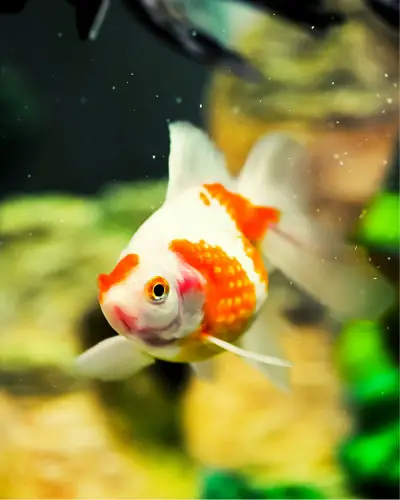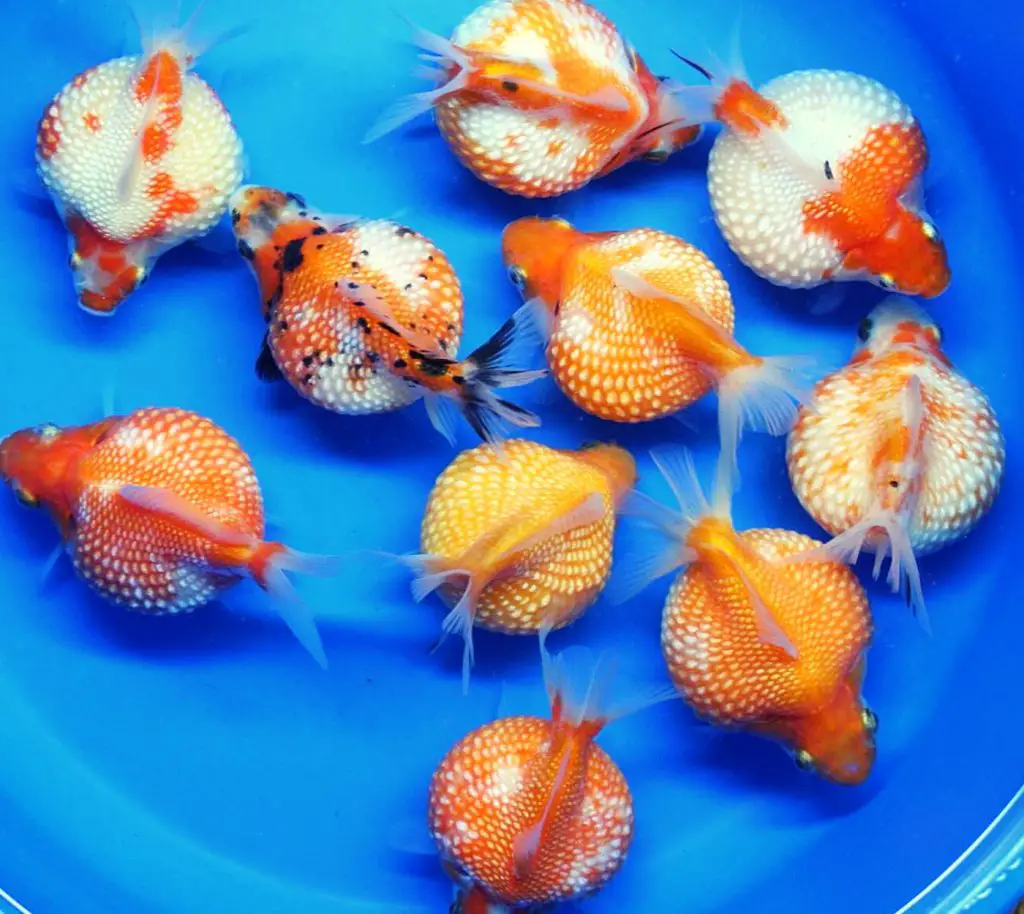Are you fascinated by the unique, round-bellied Pearlscale Goldfish? This charming fish, known for its plump body and pearl-like scales, is a favorite among aquarists. But what does it take to care for this delicate beauty?
Pearlscale Goldfish require a balanced diet, a spacious tank, and stable water conditions to thrive.
They are sensitive to poor water quality and need a well-maintained habitat. With proper care, these fish can live up to 10 years, making them a rewarding pet for dedicated fishkeepers.

But there’s much more to learn about keeping them happy and healthy. From diet tips to tank requirements, we’ve got you covered in this complete care guide. Let’s dive into the essential facts about the high head Pearlscales fish!
Table of Contents
ToggleAre Pearlscale Goldfish Hard to Keep? (Is it for you!)
Pearl scale fish are often regarded as one of the more delicate types of goldfish, primarily due to their unique physical characteristics. Their rounded bodies, which resemble a golf ball, can make them susceptible to swim bladder disease and other health issues if not cared for properly.
Additionally, their specific water parameters must be maintained to ensure their well-being, which means that novice fish keepers may find it challenging to provide the ideal environment for these fancy golf ball goldfish.

However, with proper knowledge and commitment, keeping pearlscales can be a rewarding experience. They thrive in a well-maintained aquarium or pond, and if you can ensure suitable tank mates, they can be a lively addition to your aquatic environment.
It is essential to research the best practices for their care, including the type of food they require, as pearl gold fish might have special dietary needs compared to common goldfish varieties. Ultimately, whether or not they are the right choice for you will depend on your willingness to learn and adapt to their specific needs.
Pearl Goldfish Breeding
The breeding process for pearl scale goldfish can be quite fascinating and rewarding for dedicated breeders. During the breeding season, which typically occurs in late spring or early summer, male pearlscale goldfish will often display vibrant colors and chase females around the tank, showcasing their readiness to mate.
An ideal breeding setup includes a separate breeding tank with gentle filtration and ample spawning sites, such as plants or spawning mops, to encourage successful reproduction.
Once the female lays her eggs, which are usually adhesive and will stick to the plants, the male will fertilize them. After a few days, the eggs will hatch, resulting in tiny fry that will require specialized care and feeding.
The fry should be fed with high-quality micro-pellets or powdered food until they grow large enough to consume larger pellets. With patience and attention to detail, breeding pearlscale goldfish can lead to a successful outcome, allowing you to enjoy and share these beautiful fish with others.
Pearl Scale Gold Fish Coloration
Goldfish pearlscale exhibit a variety of stunning colors and patterns, making them one of the most visually appealing ryukin goldfish varieties available.
The coloration can range from solid calico to vibrant orange or yellow, and their unique pearl-like scales further enhance their aesthetic appeal. The scales cover their rounded body, giving them a distinct look that sets them apart from other goldfish, such as the fantail or lionhead varieties.
As these fish mature, their vibrant colors tend to become more pronounced, especially if kept in optimal conditions. The well-developed domed scales reflect light beautifully, creating a shimmering effect that captivates anyone who gazes upon them.
With the right care, goldfish pearlscale can retain their gorgeous coloration throughout their lifespan, making them a fantastic addition to any fish tank or pond and a focal point in your aquatic collection.
Goldfish Pearlscale Tank Requirements
Creating the best tank environment for pearl scale goldfish is crucial to their health and happiness. A minimum of a 20-gallon tank is recommended for a single ping pong goldfish, with additional space required for each additional fish.
They prefer a well-filtered aquarium with stable water parameters, including a water temperature range of 68-74°F and a pH level between 6.5 and 7.5. Regular water changes and monitoring are essential to prevent harmful toxins from accumulating in the tank.
Moreover, providing adequate swimming space is vital, as pearlscale goldfish can become stressed in cramped conditions. Incorporating plants and decorations can offer hiding spots and stimulation, but it is equally important to ensure that all decorations are smooth and free of sharp edges to protect their delicate fins.
Additionally, tank mates should be carefully selected to ensure compatibility, as crown pearlscale goldfish thrive best in a peaceful environment, making it essential for fish keepers to choose suitable companions.
Commonly Asked Questions about the Goldfish Pearlscale Fish (FAQs)
What are the key characteristics of pearl scale goldfish?
Pearl gold fish are known for their round bodies that resemble a golf ball, with well-developed domed scales that cover their entire body. They belong to the fancy goldfish branch and display a pearly appearance. Their bodies may be either long or short, but they are generally bright and alert.
What type of tank is suitable for pearlscales goldfish?
A 20-gallon tank is recommended for a single goldfish pearlscale, but a larger tank is better for multiple fish. It’s important to ensure the aquarium décor is suitable and that the tank has adequate filtration, as Pearlscales can be sensitive to water quality.
What is the best tank mate for pearlscale goldfish?
The best tank mates for pearl scale gold fish are other fancy goldfish such as orandas or fantails. Avoid aggressive or fast-moving fish, as pearlscales are slower swimmers and may struggle to compete for food.
What do pearlscale goldfish eat?
Pearl scale goldfish thrive on a diet that includes high-quality flake foods, pellets, and occasional treats like blanched vegetables. It’s essential to monitor how much they eat to prevent overfeeding, which can lead to health issues.
How do pearlscale goldfish differ from other goldfish varieties?
Pearl scale gold fish are distinct due to their unique egg shaped body and well-developed, pearly scales. While they share similarities with varieties like the oranda and fantail goldfish, their round body is a defining characteristic that sets them apart.
Are pearlscale goldfish hardy?
Yes, pearlscale goldfish are considered one of the hardier species among goldfish. Like most goldfish, they can adapt well to various environments, but they still require proper care to thrive.
Can pearlscale goldfish jump out of the tank?
Yes, pearl scale gold fish can jump, much like other goldfish. It’s essential to keep a secure lid on the aquarium to prevent them from jumping out, especially during feeding times or if they are startled.
What should I do if I notice changes in my pearlscale goldfish’s behavior?
If you observe unusual behavior, such as lethargy or changes in appetite, it’s crucial to check the water quality and ensure it is within the optimal parameters. Additionally, inspect for any signs of illness and consult a veterinarian if necessary.
How can I tell if my pearl scale fish is healthy?
A healthy pearl scale gold fish will have bright and alert eyes, smooth and well-developed scales, and will be actively swimming. Regular feeding habits and a good appetite are also indicators of good health.
How big do pearlscale goldfish get?
Pearlscale Goldfish typically grow 6-8 inches long. Their size depends on tank conditions, diet, and care. Provide ample space and proper maintenance for healthy growth.
Why are pearlscale goldfish round?
Pearl scale Goldfish are round due to selective breeding, which emphasizes their unique, balloon-like body shape and distinct pearl-like scales for ornamental appeal.
How long do pearlscale goldfish live?
They typically live 10-15 years with proper care, including a spacious tank, clean water, balanced diet, and regular maintenance for optimal health.
Conclusion about Calico Pearlscale
Pearl gold fish are a beautiful and unique addition to the world of fancy goldfish, offering a delightful combination of visual charm and interactive behavior. While they may require a bit more attention and care than some other goldfish varieties, the rewards of keeping these stunning creatures far outweigh the challenges. With a solid understanding of their dietary needs, breeding processes, and tank requirements, you can create a thriving environment for your Pearlscales fish species.
Ultimately, whether you are an experienced fish keeper or a beginner, the pearlscale goldfish can bring joy and beauty to your aquarium or pond. Their distinct rounded bodies and vibrant colors can become a centerpiece in your aquatic collection, captivating both you and your guests. By investing time and effort into their care, you will enjoy the benefits of having these enchanting fish in your home for years to come.
You might also like
- Breeding Lionhead Goldfish – The Ultimate Guide to Success!
- 5 Easy Steps to Create a Stunning Fantail Goldfish Aquarium!
- Is Breeding Goldfish Profitable: 5 Key Benefits to Consider!
- TOP 10 Smallest Breed of Goldfish That You Can Keep As Pets
- How Many Goldfish in a 10 Gallon Tank (Exact Numbers Solved)




